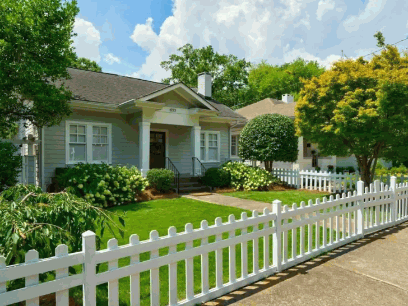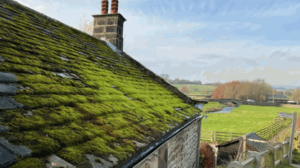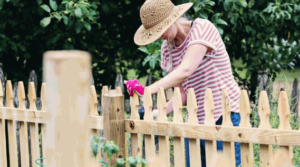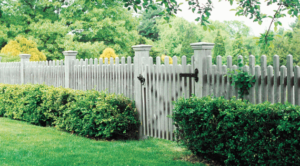Picket fences have long been a symbol of charm and security in residential landscaping, evoking images of idyllic homes and cozy neighborhoods.
This article explores the essence of picket fences, tracing their rich history and examining the various styles that grace our gardens.
From traditional designs to modern alternatives, we uncover the materials used in their construction, guide you through installation and maintenance, and discuss the benefits and challenges of having one.
Whether you’re considering adding a picket fence to your property or are simply curious about this timeless feature, there’s something here for everyone.
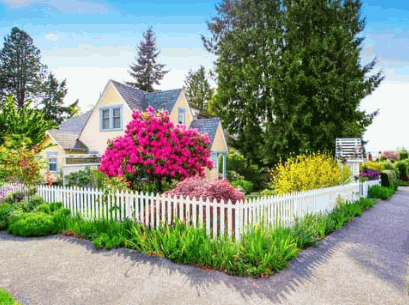
What Is A Picket Fence?
A picket fence is a quintessential element of Americana, often symbolising a nostalgic charm and the ideal middle-class suburban life.
Characterised by its distinct vertical boards and often painted in white, the white picket fence evokes a sense of warmth and security, serving as an iconic representation of the American dream.
These fences not only enhance kerb appeal but also provide a decorative way to contain pets and create charming boundaries around homes.

History Of Picket Fences
The history of picket fences dates back to the early colonial era in the United States, where their historical craftsmanship served practical purposes in delineating properties and containing livestock, as seen in historical landmarks like Mount Vernon. These structures evolved from simple wooden fences to the ornate designs popular in the Victorian era, reflecting the changing aesthetics and values of Americana.
Over time, the design of these fences became symbolic, often associated with the idyllic image of the American dream and the pursuit of home ownership.
During the colonial era, picket fences were primarily functional, constructed using materials that were readily available, such as timber from local forests. As society progressed into the Victorian era, the focus shifted towards aesthetics, with more elaborate styles emerging to showcase individuality and craftsmanship.
- In urban settings, picket fences featured decorative elements like finials and intricate lattice work, as well as decorative finials that enhance their beauty.
- In rural areas, they retained their practical charm, often painted white to match the symbolism of purity and respectability.
As communities grew and changed, so did the significance of these iconic barriers, making them a longstanding element of Americana and a testament to the American dream.
Types Of Picket Fences
Picket fences come in a variety of styles, each offering unique aesthetic and functional benefits to homeowners looking to enhance their outdoor features. From traditional picket fences that convey classic charm to scalloped designs that add visual interest, options like Gothic and French Gothic picket fences elevate the decorative aspects.
Dog-ear and spaced picket variations cater to different preferences, making them versatile fencing options for any garden.
Traditional Picket Fences
Traditional picket fences are often seen as a classic choice for British homes, embodying the charm and nostalgia associated with suburban life. These fences typically feature evenly spaced vertical boards with pointed tops, which create a tidy and inviting appearance while serving practical purposes.
In many neighbourhoods, these structures not only define property boundaries but also enhance the overall kerb appeal of a home. Often crafted from wood, they can also be made from vinyl or metal, allowing for variations in durability and maintenance.
The historical roots of picket fences can be traced back to colonial times, where they symbolised domesticity and family values.
- The design often incorporates decorative elements, such as unique post caps or intricate lattice work, adding a personal touch.
- These fences serve as a backdrop for gardens, making them a favourite among homeowners seeking to create an inviting outdoor space.
- Picket fences continue to be a beloved choice, reflecting a timeless aesthetic that speaks to both history and modern sensibilities.
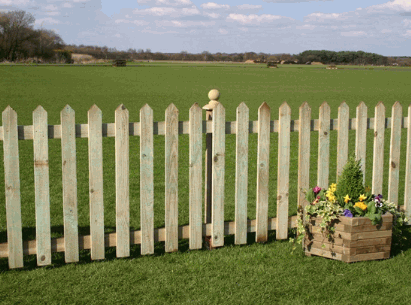
Scalloped Picket Fences
Scalloped picket fences incorporate a unique wave-like design that adds visual interest and charm to any outdoor space, making them a popular choice among homeowners.
This style not only enhances the aesthetic appeal of the property but also serves as an effective boundary, making it a popular choice for homeowners looking to create inviting and picturesque landscapes. The captivating curves of scalloped designs allow for a soft, welcoming look that stands out against traditional straight-edge styles.
These fences can be made from various materials, including wooden fences, vinyl, and metal, each bringing its own character and durability to the project’s installation process.
When comparing scalloped fences to other styles, many homeowners appreciate how the gentle undulations can soften the appearance of garden spaces, contrasting beautifully with geometric designs often seen in contemporary landscaping. They are also ideal for gardens, play areas, or front gardens, providing charm while still allowing visibility and light.
- Benefits of scalloped picket fences:
- Enhanced visual aesthetics
- Effective property boundary
- Variety of materials available
- Softens harsh lines of landscaping
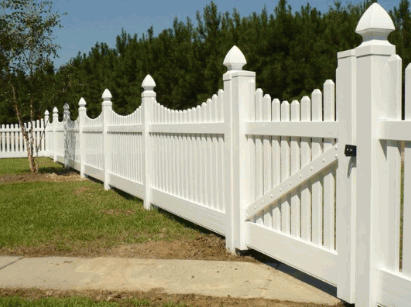
Gothic Picket Fences
Gothic picket fences stand out with their distinctive pointed tops, which evoke a sense of elegance and tradition. This style often features taller and more ornate designs, making it a preferred choice for those looking to add a touch of sophistication to their property.
Characterised by their graceful silhouettes, these fences not only serve as barriers but also enhance the overall aesthetic of a home. A mastery of vertical lines and intricate details communicates a unique charm, appealing to a variety of tastes in architectural design. When considering suitability, Gothic picket fences complement Victorian and Gothic Revival styles exceptionally well, while also adding a beautiful contrast to more modern settings.
- Unique pointed finials
- Ornate carvings and decoration
- Elegant height that draws the eye
Beyond their visual appeal, the historical significance of Gothic picket fences lies in their ability to evoke a sense of nostalgia, reminding one of the richly textured past of American neighbourhoods. Their suitability across diverse architectural styles makes them an enduring favourite for homeowners desiring to express individuality through exterior design.
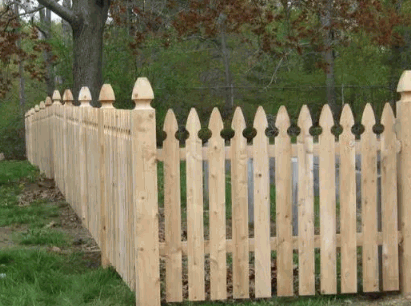
French Gothic Picket Fences
French Gothic picket fences feature ornate designs and decorative elements, such as ornamental tops that enhance their visual appeal. These fences are often characterised by intricate craftsmanship, making them ideal for homes aiming for a sophisticated aesthetic.
Not only do these elegant fencing structures showcase a unique artistic flair, but they also provide a sense of privacy without overwhelming the landscape. Crafted from durable materials, French Gothic picket fences can withstand various weather conditions, ensuring longevity.
Their vertical lines and pointed arches complement both traditional and modern homes, allowing them to seamlessly integrate into a range of outdoor themes.
- Perfect for gardens: These fences can beautifully frame flower beds.
- Privacy in style: They offer a delicate balance between openness and seclusion.
- Versatile aesthetics: Suitable for both rustic and contemporary designs.
When paired with climbing plants or decorative lighting, these fences can become a stunning focal point in any garden, further enhancing the overall charm of the property.
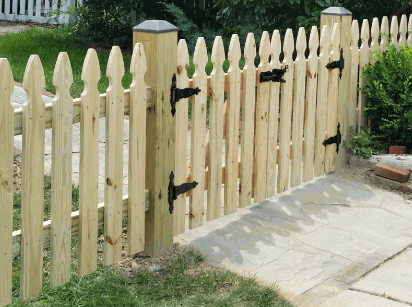
Dog Ear Picket Fences
Dog ear picket fences are recognised for their practical designs, characterised by the unique cut on the top of the pickets resembling a dog’s ear. This style not only adds a subtle decorative touch but also offers durability and low-maintenance benefits for homeowners, making it an ideal choice for those seeking a functional yet aesthetically pleasing boundary solution for their property.
One of the prominent advantages of dog ear picket fences is their versatility in design, which allows them to complement various architectural styles, from traditional to contemporary. Crafted from high-quality materials such as wood, vinyl, or metal, these fences can be tailored in height and spacing to meet specific needs.
- Durability: They withstand the elements effectively, minimising the need for repairs and replacements over time.
- Security: While offering a friendly appearance, they also provide an adequate level of security for pets and children.
- Affordability: In many cases, they represent a cost-effective fencing option compared to more elaborate designs.
Whether used in urban neighbourhoods or rural settings, these fences stand out as a smart investment for homeowners looking to enhance their property’s appeal and functionality, providing a lasting legacy of historical significance.
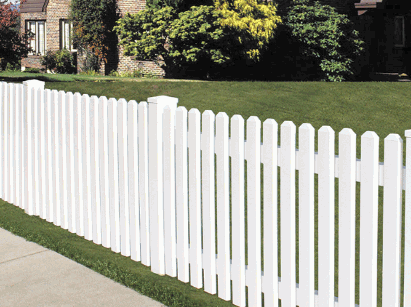
Spaced Picket Fences
Spaced picket fences are distinguished by their intentional gaps between the pickets, offering a unique design element while maintaining boundary delineation. This style allows for visibility while still providing a notable border for gardens or yards.
These fences enhance the overall aesthetic of outdoor spaces by allowing sunlight to stream through the openings, creating beautiful patterns on the ground. When incorporated into well-planned landscaping, spaced picket fences seamlessly blend with flowers and shrubs, encouraging an inviting atmosphere. Homeowners appreciate how these fences can promote better air circulation, which is essential for growing plants nearby.
- They can complement various architectural styles, enhancing the character of a home.
- Due to their design, spaced picket fences often serve as practical boundaries without obstructing views, which is especially valuable in more scenic areas.
- Their low maintenance requirements can be a significant advantage for busy homeowners.
By integrating these fences into their landscapes, individuals can create a harmonious balance between functionality and beauty.

Materials Used For Picket Fences
The materials used for constructing picket fences vary significantly, with options such as wood, vinyl, aluminium, and wrought iron each offering distinct benefits and aesthetics.
Wooden fences provide a classic look but require more maintenance, whereas low-maintenance polyvinyl options are increasingly popular for their durability and ease of care.
Wood
Timber fences are the traditional choice for picket fencing, celebrated for their historical significance and classic aesthetics. While these fences exude charm and authenticity, they do come with maintenance requirements that can affect their longevity.
Their classic appearance complements various architectural styles, enhancing kerb appeal and adding a touch of warmth to any landscape. The use of different types of timber, such as cedar and pine, allows for customisation according to personal preference and budget. Each wood type comes with its unique characteristics:
- Cedar is naturally resistant to decay and insects, making it a popular choice.
- Pine is more affordable but requires treatment to prevent rot.
Maintaining timber picket fences often involves regular staining or sealing to protect against weather damage, which can be time-consuming. These fences provide an aesthetic charm that can truly enhance the beauty of a property.
Delve into: How Much To Install A Wooden Fence
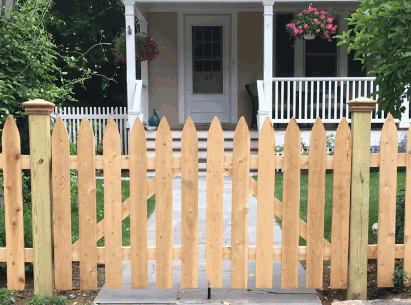
Vinyl
Vinyl fencing has gained popularity due to its low-maintenance polyvinyl construction, which resists fading and requires minimal upkeep. Available in a variety of vibrant colours, vinyl picket fences are an attractive alternative to traditional wood.
The innovative material provides impressive durability, standing strong against harsh weather conditions, pests, and rot that can often compromise wooden fences. Homeowners are increasingly turning to vinyl options for their long-lasting solutions in outdoor boundaries. The hassle-free maintenance means that periodic cleaning is often all that’s required to keep the fence looking new.
- Durability: Resistant to chipping, cracking, and warping.
- Colour Options: Choose from an extensive palette to match any aesthetic.
- Low Maintenance: No need for regular staining or painting.
By opting for vinyl fencing, one can achieve not only a visually appealing perimeter but also significant peace of mind regarding its resilience and longevity.

Aluminium
Aluminium fences are a lightweight yet durable option for picket fencing, often chosen for their modern aesthetics and resistance to various weather conditions. They provide a sleek, contemporary look while requiring minimal maintenance.
These fences are especially favoured for their remarkable strength-to-weight ratio, which allows them to withstand the rigours of outdoor exposure, including heavy winds and rain. For those looking to enhance their property, aluminium fencing comes in a variety of design options, from ornamental styles to minimalist panels, making it suitable for numerous architectural themes.
The versatility of aluminium means it can seamlessly blend into various environments, whether it’s a backyard sanctuary, a commercial property, or a pool area.
- Durability: Resistant to rust and corrosion.
- Design Options: Customisable heights, colours, and patterns.
- Suitability: Ideal for residential and commercial settings.
This adaptability makes aluminium fencing a practical choice for both aesthetic appeal and lasting performance.
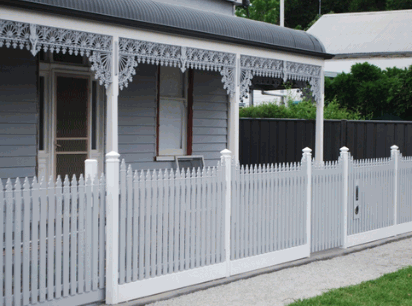
Wrought Iron
Wrought iron picket fences are known for their durability and ornamental appeal, often adorned with decorative finials and intricate designs. This material provides a timeless elegance, making it a sought-after choice for upscale properties.
The aesthetic versatility of wrought iron allows homeowners to enhance their landscape design in a multitude of ways, merging functionality with style. They do come with some considerations.
- Advantages: These fences are incredibly resistant to weathering, ensuring they can withstand the elements for many years. The aesthetic appeal is unmatched, serving as a charming boundary while adding to the property’s value.
- Disadvantages: On the flip side, maintenance can be demanding as wrought iron is prone to rust if not properly coated and cared for. The initial installation costs may be higher compared to other materials.
Ultimately, wrought iron fencing offers a beautiful yet durable choice for any homeowner, provided they are prepared to manage its upkeep.
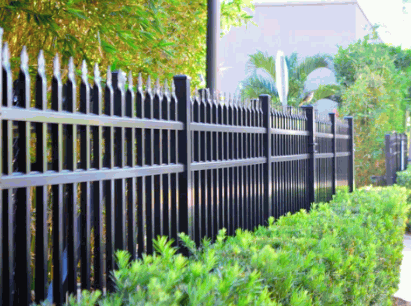
How To Install A Picket Fence?
The installation process of a picket fence involves careful planning and execution to ensure a sturdy and visually appealing result. Key considerations include height recommendations, selecting the right materials, and understanding various fencing options suited to the landscape.
Preparing The Area
Preparing the area for a picket fence installation is crucial and involves marking boundaries and clearing any obstructions. This step sets the foundation for a successful installation, ensuring that all measurements align with the intended design.
Inadequate preparation can lead to numerous complications and can ultimately compromise the integrity of the project. To avoid any potential mishaps, gather essential tools such as a tape measure, posts, a spirit level, and a string line. These will help in accurately defining the installation boundaries and ensuring precise alignment.
- Begin by measuring the desired length for the fence and strategically placing the posts at each corner.
- With the string line adjusted between posts, the vision becomes clearer, helping in marking a straight line for ultimately installing the panels.
- Keep an eye out for obstructions like roots or stones, as they can interfere with the installation process.
Employing best practices at this stage not only saves time but also significantly enhances the overall aesthetic and functionality of the completed fence.
Setting The Posts
Setting the posts is a vital step in the installation of a picket fence, as the stability of the entire structure relies on properly anchored posts. Using high-quality concrete ensures that the posts remain firm and secure over time.
When approaching this important task, it is essential to gather the right tools and materials before starting. Begin with a sturdy post hole digger, spirit level, and concrete mix, as these will be your primary implements during the setup process.
Consider using gravel at the base of each hole for improved drainage, which helps prevent moisture from compromising the integrity of the posts.
- Ensure each hole is at least one-third the height of the post.
- Check the alignment regularly with a spirit level to avoid future issues.
- Take your time mixing the concrete for a consistent texture.
By adhering to these methods and tips, one can guarantee a strong framework for the picket fence, leading to a lasting addition to any property.
Attaching The Rails And Pickets
Once the posts are securely in place, the next step involves attaching the rails and pales, which is essential for completing the fence structure. Proper installation techniques ensure that the pales are evenly spaced and aligned, enhancing both functionality and style.
To effectively achieve this, one should consider a few key methods that facilitate stability and visual appeal. Begin by aligning the rails to the posts to ensure a solid framework for securing the pales. It is advisable to use a level to check that the rails are perfectly horizontal; any misalignment can lead to problematic gaps or uneven pale heights.
- For optimal spacing, maintain a consistent gap between the pales based on the desired look—typically between 25 to 75 millimetres.
- Utilising a spacer helps to streamline this process, ensuring every pale aligns perfectly with its neighbour.
- Consider pre-drilling holes in the rails to prevent wood from splitting when fastening the pales.
By following these guidelines, the fence not only stands firm but also presents a polished appearance, amplifying the aesthetic value of any outdoor space.
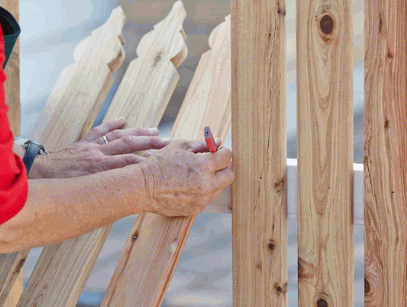
Maintenance And Care For Picket Fences
Regular maintenance and care for picket fences is essential to prolong their lifespan and preserve their aesthetic appeal, regardless of the material used. Different materials come with varying maintenance requirements, from routine cleaning to applying protective treatments.
To ensure that a fence remains sturdy and visually pleasing, it is important to adopt a tailored maintenance routine according to its material. For instance, wooden picket fences may require:
- Annual Cleaning: Removing dirt and debris at least once a year to prevent mould and decay.
- Sealing and Painting: Every 3-5 years, applying a sealant or paint can protect against weathering.
Meanwhile, vinyl fences are easier to maintain, often requiring only:
- Regular Washing: Using mild soap with water bi-annually keeps them looking fresh.
- Inspections: Check for any signs of damage or fading once a year.
Metal picket fences involve dynamic patterns and durability:
- Rust Prevention: Applying anti-rust treatments every few years.
- Annual Inspections: Looking for chips or damage to the finish regularly helps maintain its integrity.
By adhering to these specific tasks, you can help secure your fence’s durability while enhancing the overall kerb appeal of your property.
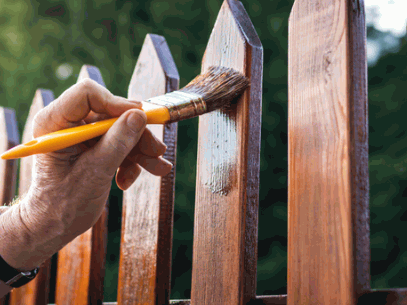
Benefits Of Having A Picket Fence
Having a picket fence offers numerous benefits that blend functionality and style, making it an ideal boundary for homes, particularly in suburban neighbourhoods.
These fences enhance kerb appeal while providing a sense of privacy and security, contributing to the overall aesthetic of the property.
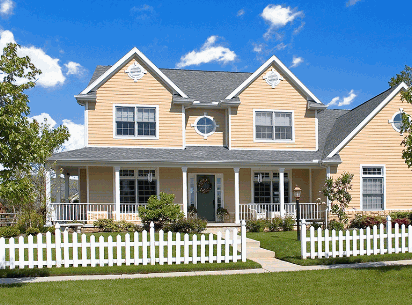
Common Issues With Picket Fences
Common issues with picket fences arise from wear and tear over time, often exacerbated by weather conditions such as rain, snow, and direct sunlight. Understanding these potential problems is crucial for selecting the right materials and maintenance practices.
Homeowners may notice wood rot as a significant concern, particularly in areas experiencing high humidity or poor drainage. This decay can weaken the structure, making it imperative to consider materials that offer better moisture resistance, such as vinyl or composite fencing.
Another common issue is paint peeling, which not only detracts from the aesthetic appeal but also leaves the fence vulnerable to further damage.
- Maintenance Tips: Regularly inspect the fence for signs of wear; applying a quality sealant can prolong its lifespan.
- Replace any damaged boards promptly to maintain structural integrity.
- Consider adding a protective coat of paint every few years to combat peeling.
Roots from nearby trees can exert pressure against the fence, leading to leaning or breaking. Therefore, careful landscaping around the fence line plays a key role in its longevity.
Alternatives To Picket Fences
There are several alternatives to traditional picket fences that can serve as decorative barriers, providing both functionality and style in outdoor spaces.
Options such as privacy fences, chain link, or even hedges offer different aesthetics and benefits that may suit various preferences and needs.
